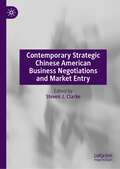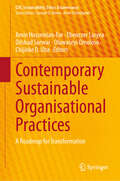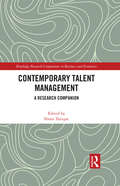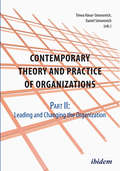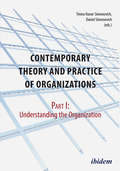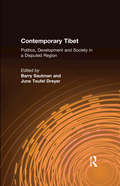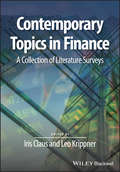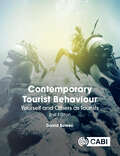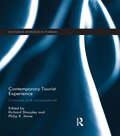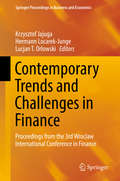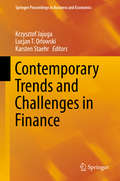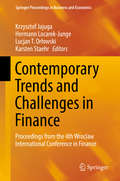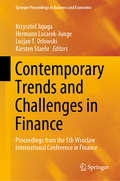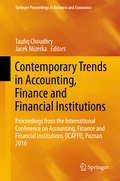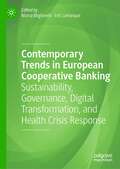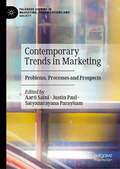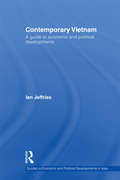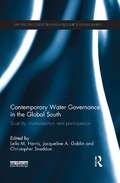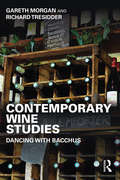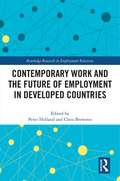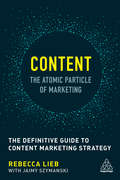- Table View
- List View
Contemporary Strategic Chinese American Business Negotiations and Market Entry
by Steven J. ClarkeThis book is an effort to provide a “primary source”, a guide for Chinese/American cross-cultural negotiations, which has been constructed and amassed by professionals living and working in China. Research included personal interviews, surveys, case studies, face-to-face negotiations, and consulting, melded with a broad body of international business. This book that has two focuses, China market entry and negotiations, Both China and the United States are vast, complex markets, with different histories and cultures. China market entry requires extensive research and understanding, of the inextricably linked elements of (a) how business is managed in China, (b) understanding the China market, and (c) negotiating all elements of your China market entry and ongoing business. To be successful in China, your firm will face these elements in terms of explicable and solvable activities. Research into data, theory, and perceptual cultural differences between your firm and your Chinese counterparts adds magnitude to your China overall business strategy, and mandatory and essential negotiations.
Contemporary Sustainable Organisational Practices: A Roadmap for Transformation (CSR, Sustainability, Ethics & Governance)
by Amin Hosseinian-Far Dilshad Sarwar Ebenezer Laryea Oluwaseyi Omoloso Chijioke D. UbaThis book provides a structured overview of contemporary sustainable organisational practices. It examines the contemporary sustainability landscape within the pillars of environment, economy and society and provides case examples for each topic. The book features discussions on sustainable governance and strategy, systems approach, and social responsibility. It is a multidisciplinary work that cuts across several subject areas ranging from strategy, business and organisational management, environmental management, engineering, to systems thinking. This book is suitable for scholars, researchers, academics, and policy makers interested in sustainability and organisational management and practice.
Contemporary Talent Management: A Research Companion (Routledge Research Companions in Business and Economics)
by Ibraiz TariqueThe field of Talent Management (TM) has grown and advanced exponentially over the past several years as an essential area of research. While interest in the field is growing, and recent research has provided valuable insight into various topics, there remain many opportunities for additional exploration and research. One such opportunity is to examine Talent Management topics related to the modern workforce and organizations - an area identified as contemporary talent management. Divided into two thematic sections that provide a unique overarching structure to organize seventeen chapters written by leading and renowned international scholars, this Research Companion assesses essential knowledge, trends, debates, and avenues for future research in a single volume. Some of the topics examined from a contemporary Talent Management perspective include Executive Search, Gifted Early Career Individuals, Managing Diverse Talents, Gender Sensitive TM, Aging Global Workforce, Leadership Wisdom, Learning Agility, Employee Engagement, Entrepreneurship, Intrapreneurship, Small Business Enterprises, Talent Flow, Green HR, Gig Workers, and Mergers and Acquisitions. In this way, the Research Companion is essential reading for anyone involved in the scholarly study of contemporary Talent Management, including academic researchers, advanced postgraduate and graduate students, and management consultants. For further debate on Traditional Talent Management, readers might be interested in the supplementary volume, The Routledge Companion to Talent Management, sold separately.
Contemporary Theory and Practice of Organizations: Part I: Understanding the Organization
by Daniel Simonovich Timea Havar-SimonovichOrganizations are the business world's central actors, employing multiple people who pursue collective goals while linked to an external environment. This volume is the first of two books dedicated to defining current theories of organizations and their practices. The text is filled with contributions by alumni of the ESB Business School at Reutlingen University. Part I discusses contemporary organizational forms and properties, including team aspects. Part II provides a detailed overview of key themes in modern leadership and coaching, as well as organizational intervention.
Contemporary Theory and Practice of Organizations: Part I: Understanding the Organization
by Daniel Simonovich Timea Havar-SimonovichOrganizations are the business world's central actors, employing multiple people who pursue collective goals while linked to an external environment. This volume is the first of two books dedicated to defining current theories of organizations and their practices. The text is filled with contributions by alumni of the ESB Business School at Reutlingen University. Part I discusses contemporary organizational forms and properties, including team aspects. Part II provides a detailed overview of key themes in modern leadership and coaching, as well as organizational intervention.
Contemporary Threat Management: A Practical Guide For Identifying, Assessing, And Managing Individuals Of Violent Intent
by Frederick S. Calhoun Stephen W. WestonThis book is dedicated to every person who has suffered from acts of intended violence and to each professional who is committed to preventing future violence.
Contemporary Tibet: Politics, Development and Society in a Disputed Region
by Barry Sautman June Teufel DreyerThe subject of Tibet is highly controversial, and Tibet, as a political entity, is defined differently from source to source and audience to audience. The editors of this path-breaking, multidisciplinary study have gathered some of the leading scholars in Tibetan and ethnic studies to provide a comprehensive analysis of the Tibet question. "Contemporary Tibet" explores essential themes and issues concerning modern Tibet. It presents fresh material from various political viewpoints and data from original surveys and field research. The contributors consider such topics as representations and sovereignty, economic development and political conditions, the exile movement and human rights, historical legacies and international politics, identity issues and the local society. The individual chapters provide historical background as well as a general framework to examine Tibet's present situation in world politics, the relationship with China and the West, and prospects for the future.
Contemporary Topics in Finance: A Collection of Literature Surveys (Surveys of Recent Research in Economics)
by Leo Krippner Iris ClausThe literature surveys presented in this edited volume provide readers with up-to-date reviews on eleven contemporary topics in finance. Topics include unconventional monetary policy, implicit bank guarantees, and financial fraud - all linked to the exceptional event of the Global Financial Crisis Explores how recent studies on inflation risk premia and finance and productivity have benefitted from new empirical methods and the availability of relevant data Demonstrates how angel investing, venture capital, relationship lending and microfinance have benefitted from increased research as they have become more seasoned Investigates crowdfunding and crypto-currencies which have both arisen from recent technological developments
Contemporary Tourism
by Chris Cooper C. Michael HallThe study of tourism and indeed the tourism industry is changing constantly. Contemporary Tourism: an international approach presents a new and refreshing approach to the study of tourism, considering issues such as the changing world order, destination marketing, tourism ethics and pro-poor tourism. In particular, it highlights the ongoing threats from terrorism and health scares faced by the tourism industry today, and discusses the related security and risk management strategies, illustrating the potential implications for the patterns and flow of tourism in the future. Divided into five sections, each chapter has a thorough learning structure including chapter objectives, examples, discussion points, self review questions, checklists and case studies. Cases will be both thematic and destination-based and always international. They will be used to emphasise the relationship between general principles and the practice of tourism looking at areas such as business and special interest tourism and the role of technology.The five sections will cover: Contemporary Tourism Systems; The Contemporary Tourist; The Contemporary Tourist Destination; Tourism Futures; Teaching and Studying Contemporary Tourism. The text will also provide an annotated, authoritative and thorough set of resources to guide the reader through the topic area including online resource sites for both students and lecturers.
Contemporary Tourist Behaviour: Yourself and Others as Tourists (Cabi Tourism Texts)
by David BowenThis fully updated edition responds to themes emerging over the decade since publication of the first edition and transmits the content into the 2020s. The themes include technological change, ethical consumption, and the tourist response to health risk, political instability and other uncertainty. Examples are introduced from all parts of the world, capturing the explosion of research on tourist behaviour, to produce a text that is strong both on theory and practical application. The second edition: - Compares classic and contemporary studies. - Evaluates recently emergent themes. - Discusses worldwide examples. - Contains extensive use of figures/tables and full colour photographic images. This is the go-to text for students and academics interested in tourist behaviour both from within the tourism field and from other fields and disciplines.
Contemporary Tourist Experience: Concepts and Consequences (Advances in Tourism)
by Richard Sharpley Philip R. StoneThis significant and timely volume aims to provide a focused analysis into tourist experiences that reflect their ever-increasing diversity and complexity, and their significance and meaning to tourists themselves. Written by leading international scholars, it offers new insight into emergent behaviours, motivations and sought meanings on the part of tourists based on five contemporary themes determined by current research activity in tourism experience:conceptualization of tourist experience; dark tourism experiences; the relationship between motivation and the contemporary tourist experience; the manner in which tourist experience can be influenced and enhanced by place; and how managers and suppliers can make a significant contribution to the tourist experience. The book critically explores these experiences from multidisciplinary perspectives and includes case studies from wide range of geographical regions. By analyzing these contemporary tourist experiences, the book will provide further understanding of the consumption of tourism.
Contemporary Trends and Challenges in Finance: Proceedings From The 2nd Wroclaw International Conference In Finance (Springer Proceedings In Business And Economics )
by Krzysztof Jajuga Lucjan T. Orlowski Hermann Locarek-JungeThis volume includes a selection of the contributions presented at the Wroclaw conference in Finance, covering a wide range of topics in the area of finance. The articles reflect the extent, diversity and richness of research areas in the field. Discussing both fundamental and applied finance, it offers a detailed analysis of current financial-market problems including specifics of Polish and Central European markets. It also examines the results of advanced financial modeling. These proceedings are a valuable resource for researchers in universities and research and policy institutions, graduate students and practitioners in economics, finance and international economics in both private and government institutions.
Contemporary Trends and Challenges in Finance: Proceedings from the 2nd Wroclaw International Conference in Finance (Springer Proceedings in Business and Economics)
by Krzysztof Jajuga Lucjan T. Orlowski Karsten StaehrThis book contains a selection of the contributions presented at the conference. The articles reflect the extent, diversity and richness of research areas in the field, both fundamental and applied finance. The target audience of these proceedings includes researchers at universities and research and policy institutions, graduate students and practitioners in economics, finance and international economics in private or government institutions.
Contemporary Trends and Challenges in Finance: Proceedings from the 4th Wroclaw International Conference in Finance (Springer Proceedings in Business and Economics)
by Krzysztof Jajuga Karsten Staehr Hermann Locarek-Junge Lucjan T. OrłowskiThis volume features a selection of contributions presented at the 2018 Wroclaw Conference in Finance, which cover a wide range of topics in finance and financial economics, e.g. financial markets; monetary policy; corporate, personal and public finance; and risk management and insurance. Reflecting the diversity and richness of research areas in the field, the papers discuss both fundamental and applied finance, and offer a detailed analysis of current financial-market problems, including specifics of the Polish and Central European markets. They also examine the results of advanced financial modeling. Accordingly, the proceedings offer a valuable resource for researchers at universities and policy institutions, as well as graduate students and practitioners in economics and finance at both private and government organizations.
Contemporary Trends and Challenges in Finance: Proceedings from the 5th Wroclaw International Conference in Finance (Springer Proceedings in Business and Economics)
by Krzysztof Jajuga Lucjan T. Orlowski Karsten Staehr Hermann Locarek-JungeThis volume features a selection of contributions presented at the 2019 Wroclaw Conference in Finance, covering a wide range of topics in finance and financial economics, e.g. financial markets; monetary policy; corporate, personal and public finance; and risk management and insurance. Reflecting the diversity and richness of research in the field, the papers discuss both fundamental and applied finance, and offer a detailed analysis of current financial-market problems, including specifics of the Polish and Central European markets. They also examine the results of advanced financial modeling. Accordingly, the proceedings offer a valuable resource for researchers at universities and policy institutions, as well as graduate students and practitioners in economics and finance at both private and government organizations.
Contemporary Trends and Challenges in Finance: Proceedings from the 6th Wroclaw International Conference in Finance (Springer Proceedings in Business and Economics)
by Krzysztof Jajuga Lucjan T. Orlowski Karsten Staehr Hermann Locarek-JungeThis volume continues to highlight the latest research contributions presented at the annual Wroclaw conference in Finance (Poland), covering a wide range of topics in the field. The chapters reflect the extent, diversity, and richness of research areas, and discuss both fundamental and applied finance. A detailed analysis of current financial-market problems including specifics of Polish and Central European markets is also part of this volume. Selected chapters also examine the results of advanced financial modeling. These proceedings are a valuable resource for researchers in universities and research and policy institutions, graduate students and practitioners in economics, finance and international economics in both private and government institutions.
Contemporary Trends in Accounting, Finance and Financial Institutions: Proceedings From The International Conference On Accounting, Finance And Financial Institutions (icaffi), Poznan 2016 (Springer Proceedings In Business And Economics)
by Taufiq Choudhry Jacek MizerkaThis book gathers the proceedings of the ICAFFI International Conference on Accounting, Finance and Financial Institutions. The main topics addressed include: corporate finance, financial markets and asset pricing, empirical finance, taxation, financial risk management, international finance, financial econometrics, financial reporting and accounting standards, managerial accounting, measuring financial performance, accounting information systems, and current issues in accounting and finance in emerging and other markets. Presenting both cutting-edge research and a broad set of methods, and combining practical and theoretical perspectives, the book offers a valuable resource for researchers, practitioners and regulators alike.
Contemporary Trends in European Cooperative Banking: Sustainability, Governance, Digital Transformation, and Health Crisis Response
by Marco Migliorelli Eric LamarqueThe cooperative banks’ business model is unique in the financial market. It is featured by democratic foundations (one-head-one-vote principle), proximity to the members and the community they serve, limited profit-seeking nature, and prudent management. However, these principles are applied in a variety of organisational structures and economic and regulatory contexts, making cooperative banks significantly different from one country to another. This book expands existing knowledge on the European cooperative banking sector by analysing recent trends affecting cooperative banks. Namely, the book discusses the role of cooperative banks in the policy and societal movement towards sustainability, including in adopting sustainable finance practices. It explores the digital transformation journey of cooperative banks and the impact of the consolidation of Fintech players in the financial services markets. It further showcases the need to evolve the cooperative banks’ governance structures and processes in order to foster (and in some cases restore) democracy and transparency in the decision-making. Lastly, the book debates the specific role of cooperative banks in the economic crisis that has followed the unfolding of the Covid-19 pandemic vis-à-vis their members and the communities they serve. Of interest to scholars, professors, students, and practitioners of banking and finance, this book will build on the existing research and explore the latest trends in the space.
Contemporary Trends in Marketing: Problems, Processes and Prospects (Palgrave Studies in Marketing, Organizations and Society)
by Justin Paul Aarti Saini Satyanarayana ParayitamThis edited volume explores marketing in the Post-COVID world and the significant changes that have recently hit the markets. It examines the newly emerging paradigms due to shifts in consumer behaviour and market responses arising from the COVID-19 crisis.The global pandemic has brought a paradigmatic change in consumer behaviour and unravelled several resilient strategies formulated and implemented by organizations to restore normalcy.This book focuses on long-term goals and survival strategies, which can be co-created with customers. Organized into seven themes, this volume will critique and connect the meaning of the “new normal” in marketing and topics such as the future of markets, post-pandemic consumer behaviour, and new marketing strategies.
Contemporary Vietnam: A Guide to Economic and Political Developments (Guides to Economic and Political Developments in Asia)
by Ian JeffriesThis book provides full details of contemporary economic and political developments in Vietnam. It continues the overview of developments up to late 2005 which were covered in the author’s Vietnam: A Guide to Economic and Political Developments (also published by Routledge, 2006). Key topics covered include Vietnam's success, in general, in maintaining high rates of growth in the face of problems such as inflation and the global financial crisis; continuing economic reforms; foreign trade and investment; battles against corruption; population growth; the determination of the Communist Party to maintain its hold on power; and Vietnam's response to public health problems such as AIDS, SARS and bird flu.
Contemporary Water Governance in the Global South: Scarcity, Marketization and Participation (Earthscan Studies in Water Resource Management)
by Leila M. Harris, Jacqueline A. Goldin and Christopher SneddonThe litany of alarming observations about water use and misuse is now familiar—over a billion people without access to safe drinking water; almost every major river dammed and diverted; increasing conflicts over the delivery of water in urban areas; continuing threats to water quality from agricultural inputs and industrial wastes; and the increasing variability of climate, including threats of severe droughts and flooding across locales and regions. These issues present tremendous challenges for water governance. This book focuses on three major concepts and approaches that have gained currency in policy and governance circles, both globally and regionally—scarcity and crisis, marketization and privatization, and participation. It provides a historical and contextual overview of each of these ideas as they have emerged in global and regional policy and governance circles and pairs these with in-depth case studies that examine manifestations and contestations of water governance internationally. The book interrogates ideas of water crisis and scarcity in the context of bio-physical, political, social and environmental landscapes to better understand how ideas and practices linked to scarcity and crisis take hold, and become entrenched in policy and practice. The book also investigates ideas of marketization and privatization, increasingly prominent features of water governance throughout the global South, with particular attention to the varied implementation and effects of these governance practices. The final section of the volume analyzes participatory water governance, querying the disconnects between global discourses and local realities, particularly as they intersect with the other themes of interest to the volume. Promoting a view of changing water governance that links across these themes and in relation to contemporary realities, the book is invaluable for students, researchers, advocates, and policy makers interested in water governance challenges facing the developing world.
Contemporary Wine Studies: Dancing with Bacchus
by Gareth Morgan Richard TresidderThe purchase and consumption of wine, whether in hospitality environments or domestic settings, has huge anthropological significance underpinned by a discourse of wine appreciation. It can be seen as a multi-sensory and symbolically status-rich activity framed by historical, social, cultural and ethical discourses. This innovative book offers a critical study of wine from social and cultural perspectives. The field of wine studies spans the spectrum of cultural and technical issues concerning the place of wine in society from viticulture, vinification, labelling, regulation, marketing, purchasing, storage and its final consumption. It combines social history and contemporary questions including the notion of terroir, the nature of protected wine designations, the pricing of wine and the different motivations for buying and consuming wine. It considers wine as a beverage, as an aesthetic exercise and as a marker of status, as well as health implications and legal controls. The title offers a timely contribution into the significance of wine and the role of knowledge, both of which have conceptual and managerial implications in terms of marketing, promotion, consumption and distribution. By offering a holistic and innovative understanding of wine and its consumption, it is a must-read for students and scholars in the fields of wine and social science.
Contemporary Work and the Future of Employment in Developed Countries (Routledge Research in Employment Relations)
by Peter Holland Chris BrewsterWhilst only in the second decade of the 21st century, we have seen significant and fundamental change in the way we work, where we work, how we work and the conditions of work. The continued advancements of (smart) technology and artificial intelligence, globalisation and deregulation can provide a ‘sleek’ view of the world of work. This paradigm can deliver the opportunity to both control work and provide new challenges in this emerging virtual and global workplace with 24/7 connectivity, as the boundaries of the traditional organisation ‘melt’ away. Throughout the developed world the notions of work and employment are becoming increasingly separated and for some this will provide new opportunities in entrepreneurial and self-managed work. However, the alternate or ‘bleak’ perspectives is a world of work where globalisation and technology work together to eliminate or minimise employment, underpinning standardised employment with less and less stable or secure work, typified by the rise of the ‘gig’ economy and creating more extreme work, in terms of working hours, conditions and rewards. These aspects of work are likely to have a significant negative impact on the workforce in these environments. These transformations are creating renewed interest in how work and the workforce is organised and managed and its relationship to employment in a period when all predictions are that the pace of change will only accelerate.
Contending Economic Theories: Neoclassical, Keynesian, and Marxian
by Richard D. Wolff Stephen A. ResnickA systematic comparison of the three major economic theories, showing how they differ and why these differences matter in shaping economic theory and practice.Contending Economic Theories offers a unique comparative treatment of the three main theories in economics as it is taught today: neoclassical, Keynesian, and Marxian. Each is developed and discussed in its own chapter, yet also differentiated from and compared to the other two theories. The authors identify each theory's starting point, its goals and foci, and its internal logic. They connect their comparative theory analysis to the larger policy issues that divide the rival camps of theorists around such central issues as the role government should play in the economy and the class structure of production, stressing the different analytical, policy, and social decisions that flow from each theory's conceptualization of economics.The authors, building on their earlier book Economics: Marxian versus Neoclassical, offer an expanded treatment of Keynesian economics and a comprehensive introduction to Marxian economics, including its class analysis of society. Beyond providing a systematic explanation of the logic and structure of standard neoclassical theory, they analyze recent extensions and developments of that theory around such topics as market imperfections, information economics, new theories of equilibrium, and behavioral economics, considering whether these advances represent new paradigms or merely adjustments to the standard theory. They also explain why economic reasoning has varied among these three approaches throughout the twentieth century, and why this variation continues today—as neoclassical views give way to new Keynesian approaches in the wake of the economic collapse of 2008.
Content - The Atomic Particle of Marketing: The Definitive Guide to Content Marketing Strategy
by Rebecca LiebDISTINGUISHED FAVOURITE: NYC Big Book Awards 2017Content, in all its forms, is the single most critical element of any marketing campaign. Finding a successful equilibrium between content marketing and content strategy is difficult, but essential. Content - The Atomic Particle of Marketing goes beyond superficial descriptions of how to produce engaging social media content to offer the results of many years of deep quantitative research, and hours of interviews with senior marketers at some of the world's leading brands. Written by a recognized industry thought leader, Content - The Atomic Particle of Marketing explores how content functions in the broader framework of all marketing, as well as organizational concerns and IT decision making. It demonstrates the value content brings not only to "owned" media initiatives, such as a company website or blog, but also the essential role content plays in all other marketing initiatives, from social media to advertising to offline channels. It will enable readers to make the organizational, staffing, tools and process decisions necessary to get content up and running across divisions and organizational silos. Deeply researched and insightful, Content - The Atomic Particle of Marketing is, quite simply, the definitive research-based guide to content marketing.
